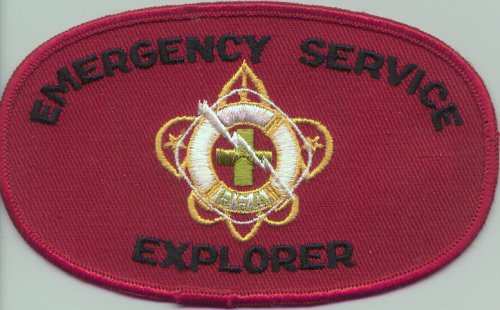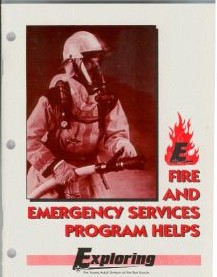


Overview
Staring in 1939, a series of Emergency Service programs were put in place
for older Boy Scouts (and Explorers). The idea was to have older boys
be prepared to assist in various emergency situations by having them be certified
in various skills to earn the right to participate. Insignia was created,
both for uniform wear and as armbands, and requirements were set to earn
the right to wear such insignia. If a unit had a certain number of
members certified in Emergency Service, then the unit was considered an Emergency
Service Unit. Thus was the Emergency Service programs created.
In the beginning, the program grew out of the general need of preparedness for World War II on the home front and from earlier BSA programs. In the postwar years, the program continued with the heightened need for Civil Defense and emergency preparedness. As part of this program, every Boy Scout and Explorer unit were supposed to have a mobilization plan. Starting in the 1960s, the need for these sorts of programs started to decline, in part due to the beginning of Emergency Medical Response systems in most communities, and the program was apparently dropped in the early 90s. However, in part this program continues in the various Search and Rescue and Fire Rescue Explorer Posts and Venturing Crews. It is unfortunately that with the seeming increase in various emergency situations around the country (floods, tornados, earthquakes, hurricanes, etc.), that the need for these programs is not recognized. Perhaps its the fear of litigation should a Boy Scout or Venturer get injured somehow in performing emergency service work that prevents the BSA from reviving such a program, as well as the increase in profession groups to handle these situations.
EMERGENCY SERVICE CORPS (1939-48)
The 1941 Requirements for Emergency Service Corps
Member:
1. First Class Scout
2. 15 years old
3. Pass these qualification tests each year:
a) Run 1 mile in 8.5 minutes
b) Climb an 18 foot rope, hand over hand, in 15 seconds
c) Tie following knots with a 1/2 in rope or larger: Square,
Bowline, Ant line hitch, Blackwall hitch, Two half hitches, Cat's paw, Clove
hitch, Bowline on a Bight, Sheet bend
4. Hold following merit badges:
a) First Aid
b) Safety
c) Pioneering
d) Personal Health
e) Firemanship
f) Public Health
g) Lifesaving*
h) Rowing*
*-where required.
The 1941 Requirements for Emergency Service Corps
Apprentice
First Class scouts who had not meet all the above qualifications could be
apprentices.
| KHAKI armband | 
|

|

|

|

|

|
EMERGENCY SERVICE EXPLORER (1949-62?)
To see two sets of requirements, go here.

|

|

|

|
oval armband, NO PICTURE |
READY EXPLORER (1962-69)
Boy Scout Troops were expected to instead be "Prepared Troops", which required that the unit complete 3 projects in the area of fitness, training, and mobilization participation. Packs could be a "Family Alert" pack if they qualified in the area of fitness and training.
This was all detailed in the Emergency Preparedness, BSA booklet from 1964.
EMERGENCY SERVICE (1969 - early 90s)

|

|
Literature
Over the years, some literature was produced for these programs. Also
listed is some literature in this area from before this program was put into
place. I have little of it. If someone can supply more information,
it would be appreciated.
The 1950s had a whole series of books on emergency preparedness/civil defense.
The Emergency Preparedness, BSA booklet from 1964 gives detailed
information on the Ready Explorer, Ready Explorer Post, Prepared Boy Scout
Troop, and Family Alert Cub pack programs of that time.
| Signal Emergency Units 1919 |
NO PICTURE |
| Scout Emergency Units for Older Scouts- First Aid
1919 18pg (shown) 1925 Scout Emergency Units for Older Scouts- Signaling 1919 18pg (shown) 1924 1925 |


|
| Scout Emergency Units 1926 1930 |
NO PICTURE |
| Emergency Service Training Plan (#3915)
1940 1941 |

|
| Emergency Service Training Plan Reference Materials
(#3925) 1941 |

|
| Putting the Emergency Service Plan into Action (#??)
1941 |
|
| Training for Mobilization (#3049) 1940 30M940 pamphlet, 15pg |

|
| Survival-Civil Defense-Emergency Services Program
Series
Family "Be Prepared" Plan (#3194) |

|
| Emergency Preparedness, BSA (#3189) 1964 50M464 booklet, 62pg |

|
| Emergency Service (#6609) 1971 1985 other printings? |
NO PICTURE |
| Fire/Emergency Services Program Helps(#23-327)
1990s booklet |

|
Updated: 04/01/2003mrb